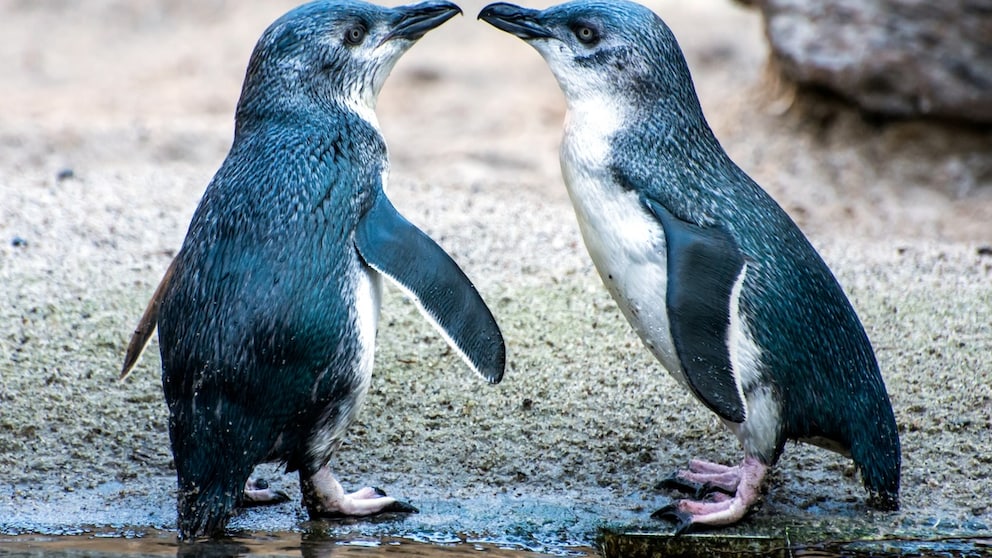February 5, 2025, 4:06 pm | Read time: 5 minutes
Anyone who watches a lot of nature documentaries knows that penguins are a symbol of lifelong fidelity. However, a study shows that this is not the case. In fact, surprisingly high “divorce rates” seem to be even better for the animals than stubborn monogamy.
The concept of lifelong monogamy is rarer in the animal world than many people think. In penguins, for example, it is often assumed that they mate with the same partner every year. However, recent research shows a more complex picture. While some species do indeed form long-term pair bonds, infidelity or even a complete change of partner through a “divorce” is not uncommon among penguins.
Do Penguins Really Live Monogamously?
Many penguins live with one partner during the breeding season. This is nothing unusual at first and also occurs in many other bird species. However, breeding pairs of Adelie, emperor, or gentoo penguins often reunite with the same partner in the next breeding season and can also form longer-term bonds with shared care responsibilities for the offspring.
This has led many to recognize a kind of fidelity and even monogamy in this behavior. However, outside of the breeding season, the animals are alone. Some species spend just one month of the year with their partner. Therefore, this complete separation after the young have been raised does not seem to indicate a lifelong bond but rather a partnership of convenience.
Rather, it can be said that penguins simply have no reason to choose another partner in the next season if it worked out with the last one. So penguins always stay together if the breeding success was high, the partner was fit and there was always enough food. However, if one of the partners does not appear in time, penguins are quick to look for “a new one.” Yes, even cases of “infidelity” are known – especially among emperor penguins. 1
“Divorces” in Penguins Are Much More Common Than Expected
A long-term study of little penguins has shown that there are actually quite high “divorce rates” among them. Researchers at Monash University in Melbourne spent 13 years studying a population of 37,000 animals on Phillip Island. The study was published in the journal Ecology and Evolution.
In the megacolony on Phillip Island, around 70 nesting boxes were monitored each year. The penguins were also fitted with electric transponders to track mating and reproduction patterns. A “divorce” was recorded when a penguin bred with a different partner in a new season, even though its previous partner was still present in the colony.
Previous studies have shown that seabirds such as penguins also have to adapt their breeding strategy to environmental conditions. The researchers therefore also recorded fluctuations in sea temperature, changes in food availability and climatic phenomena such as El Niño. This is because they suspected that these factors could have a significant impact on the chances of reproduction.
It is also known that stable pair bonds are often associated with a higher reproduction rate, while a change of partner can have short-term disadvantages. This can affect the number of eggs per pair, hatching rate, and chick survival rate. The duration of foraging has also been documented, as it also influences brood care.
“Divorce Rate” Higher in Penguins Than in Humans
In the years studied, the researchers were able to observe a total of 250 “divorces” among the penguins. As the nesting boxes were not always fully occupied, this corresponds to a separation rate of around 50 percent. By comparison, the divorce rate in Germany was 35.7 percent in 2023, according to data from the Federal Statistical Office.
However, for penguins, “marital disputes” are less about who takes out the garbage or cleans the bathroom more often. Instead, environmental factors were found to have a significant influence on “divorces.” This is because couples often split up because breeding success failed to materialize or one of the partners took too long to return to the nest at the beginning of the season due to the strong El Niño winds.
Nor does the high divorce rate of the penguins have to be particularly negative. In the season in which the birds had to look for a new partner, reproduction was somewhat slower and fewer chicks hatched. However, in the longer term, this effect led to greater success with a fitter partner with a better nest so that more chicks fledged.

Looks like mandalas This fish creates works of art to attract females

Stress and unclear loss rates Why animal welfare activists criticize today’s racing pigeon breeding

Native bird of prey The reason why buzzards attack people who are jogging
Divorces in Penguins Never Happen Without a Reason
The study also found that foraging has an influence on reproductive success in penguins. Shorter foraging trips after hatching resulted in more chicks fledging, while longer foraging trips during breeding resulted in more eggs.
But only to a certain extent. If a penguin took too long to forage, the partner had to find something to eat itself to avoid malnutrition. During this time, however, the eggs were unattended, which led to a lower hatching rate. Accordingly, reproductive success was no longer a given and the probability of a “divorce” in the next season was greater. Love – or a successful breeding partnership – clearly goes “through the stomach” in penguins, too.
The results of the study call into question our romanticized image of faithful penguin couples. However, they also show that social dynamics play a decisive role in reproduction – and that “it’s complicated” could also be considered a relationship status among penguins. This is because their social behavior is much more complex than previously thought and is also influenced by various environmental phenomena. 2

